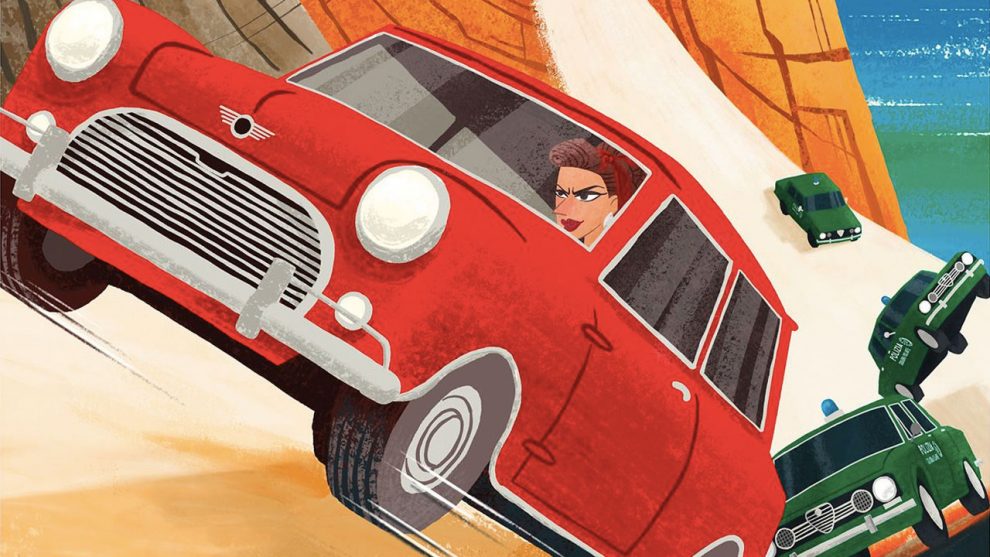Much like the popular Bruno Cathala game Mr. Jack, Getaway Driver is an asymmetric two-player game where one player is trying to catch the other. But that’s where the similarities end. In Getaway Driver, The Police chase The Driver through an ever-evolving map, trying to corner them before they can escape.
The Cityscape, as it Stands
Setting up the game, you’re faced with a pretty empty table. The Driver has a modest handful of cards– special, one-time powers that let them mess with the game. The Police player has a few cards too, but these are more like reminders– they’re always available, waiting for The Police to spend enough to activate them. A single starting tile sits in the center of the play area, with the flashy red car of The Driver square on top of it. The Police begin a couple spaces away, their car idling in wait without a tile underneath.
Over the course of the game, The Driver will push against the limits of the map. Every time they do that, more tiles are added. The map sprawls like an urban Carcassonne, with tiles branching outwards as the chase defines the limits of the city. That police car may not be off the map for long.
But back to set-up, things take an unusual turn. The Driver gathers a handful of small yellow cubes and sprinkles them across the table, like putting croutons on a salad. Then, one-by-one, The Police player adjusts these cubes to assure that they’re all in the Goldilocks Zone– not too close, and not too far apart.

The quasi-random cube drop shapes the trajectory of The Driver over the course of the game. These “Stash cubes” allow The Driver to retrieve one of their more valuable resources: their cards. In this way, the cubes form a kind of backbone for the map… the Driver might never collect them, but they’re goalposts to shoot towards.
This ritual– the cube toss, and the little adjustments that follow– is the main reason why Getaway Driver happens in what the designers refer to as “real space”. Is The Driver getting too close to the edge of the table? In any other game, you’d be inclined to delicately shuffle the whole map to the side, taking care not to upset any tokens or markers. Getaway Driver has, in my eyes, a much better solution: if you run out of table, too bad. Better crank the steering wheel and choose another alleyway. I really like this policy. It forces The Driver to think carefully, tactically. The designers go so far as to suggest that experienced players may want to try out a smaller table, to increase difficulty for The Driver. This, though, I can imagine some people taking issue with. The idea that a physical trait of your furniture can sculpt a game’s difficulty may not be everyone’s cup of tea. Me? I think it’s neat.
The Police
In Getaway Driver, the player acting as The Police is actually juggling two very different roles. Part of their job is to maneuver their fleet of vehicles– after all, the whole goal of their game is to corner the Driver. Their other role is help the city grow.
Since The Police are not as agile as The Driver, they rely on power by numbers: several vehicles may be blocking in The Driver at any given time. To help build a perimeter, The Police can use “Enforcement cubes” for sweet new cars or to move an existing fleet into a better spot. But their powers are more predictable and less disruptive than that of The Driver. (One important distinction between Enforcement and Stash cubes is that Stash cubes are a finite resource, but Enforcement cubes aren’t. The Police can earn new cubes every round.)

Where the real power of The Police can be found is in their interaction with the map. At the start of each round, new tiles are drawn so that The Driver has different options for which way to go: left, right, or straight. This draw is sculpted carefully by The Police. As tiles are drawn, The Police player carefully reviews the selection. Some tiles may obstruct The Driver; others provide a clear path. Some tiles, once revealed, grant The Police precious Enforcement cubes– a desperately needed edge against The Driver’s flight.
The Driver
On any given turn, The Driver is faced with three questions:
- Where am I going?
- What hazards do I leave behind?
- Is now the right time to use my special cards?
The first question is intuitive. The Driver will be choosing whether or not to turn, and then rolling forward one space (if they want to, which they probably do). But entangled with this movement is a sense of exploration: new tiles are flipped over only when the Driver chooses to interact with them. A clever Driver will anticipate where The Police may have placed hurdles, and will weigh the benefits of going the “obvious” direction against the dangers of a potential trap.
The second question– hazards– is a unique power to the driver. When they drive onto a space, most tiles give them a choice whether or not to leave a hazard for the tailing police cars. In most cases, The Police are unable to safely cross a hazard, which creates a real barrier between The Driver and their pursuer. Better yet, tailing police cars can be caught by hazards, causing them to crash and removing them from play. But the trouble is, even the most agile getaway driver isn’t perfect… they have to contend with the hazards too. And to do that, they’ll have to play one of their precious cards. Cards that could otherwise be used for big, fancy powers! Because remember, cards are a limited resource which is why The Driver is always thinking about question 3. Deciding to leave a hazard behind is a little like shooting yourself in the foot to hit someone else in the chest. Hazards in this game are a clever balance of self-harm and self-preservation, which I think is neat. Like 2016’s Celtic fight for supremacy Inis, Getaway Driver will let you attack your friends… but not without a real cost to yourself.

With The Driver, there’s always two plates spinning. In the peripheral is their goal: break enough new ground to run out of tiles and win the game. On the other hand, a more immediate threat is there in the form of The Police. Part of what keeps the tension going in Getaway Driver is keeping a good balance between turn-to-turn cop dodging and the real end goal of pushing the map out until it’s all gone. It’s a cool juggling act, and one that leaves you wondering when it’s time to pull that e-brake and get the hell outta Dodge.
The Feeling
At the end of the day, Getaway Driver doesn’t really play how you might expect. It asks you to make thoughtful decisions that weigh your odds against your opponent’s tricks. There are big moments, like when The Driver plays their last card in a final effort to escape. It’s definitely exciting, but it’s exciting in a way that makes you scratch your chin and say hmm. People looking for a real-time thriller may be surprised to find something asking for a little more thought.
When the game is at its climax, two timers are ticking down simultaneously: the bag of tiles tends to run out just when The Police are closing in on The Driver from all sides. This is also around when the Driver’s bag of tricks becomes alarmingly empty… with only so many cards to keep The Police on their toes, a careless overreach can end the game. It’s this dance that makes the end of the game satisfying– something that can leave you wanting a rematch.

Where Getaway Driver succeeds is in the nature of the obstacles you face. Almost all the tension in the game– from the powerful card plays to the threats on a new city tile– are sculpted by the players. This makes Getaway Driver a kind of duel. Every thrust has a parry, and you have to anticipate the dagger hidden in your enemy’s boot. This is also a big part of what makes the game a little procedural: someone at the table will always know what’s coming. The trick is to make sure that person is you.
Closing Thoughts
Getaway Driver is a clever take on the asymmetric two player genre. The two roles feel genuinely balanced, and the crazy powers up The Driver’s sleeve never feel unfair.
I will say this: in a game where big moves can shake up the whole board, there are some ambiguities in the rules that can leave some things up for interpretation. There were moments in our games where we weren’t sure exactly what we were allowed to do with the powers we had. That said– it would be unfair to assume that these rules are final. The copy provided for this review was a prototype, and it’s more than possible that any kinks in the system will be worked out by the time Getaway Driver’s Kickstarter ends up on people’s doorsteps. Even in this form, the engine worked well enough to get the game gliding along smoothly– we just needed to make a couple more judgement calls than I would have liked.
In a similar vein, please note that the images in this review are from the pre-release prototype and will not reflect final components in the game.
All prototype rumblings aside, did I enjoy Getaway Driver? Well, I’ll put it this way: it’s always a good sign when I catch myself thinking about my strategy. How could I have played that better? I found myself idly considering how to up my game over and over in the days that followed. If you’re a fan of two-player showdowns like Mr. Jack, consider checking out their Kickstarter.
Disclaimer: Uproarious Games provided us a free copy of Getaway Driver for review, but the thoughts expressed here are my own.












Add Comment